Human Resource Management Report: Learning Culture at Marks & Spencer
VerifiedAdded on 2023/01/16
|11
|3308
|73
Report
AI Summary
This Human Resource Management report delves into the significance of a learning culture for organizational sustainability and competitive advantage, using Marks & Spencer as a case study. The report examines employee engagement, the benefits and challenges of line managers in fostering continuous development, and a critical analysis of their reactions in facilitating employee growth. It highlights the importance of a learning environment, the benefits of a learning culture, and the critical role of line managers in promoting continuous development and improving organizational performance. The report also provides recommendations for senior leadership teams to encourage a true learning environment and improve employee engagement. The report also covers the importance of diversity and inclusion and the role of line managers in creating a positive and productive work environment. It emphasizes the need for continuous feedback, training, and development programs to enhance employee skills and overall organizational success. Finally, the report highlights the importance of a positive and proactive approach from line managers to foster a culture of continuous learning and development.
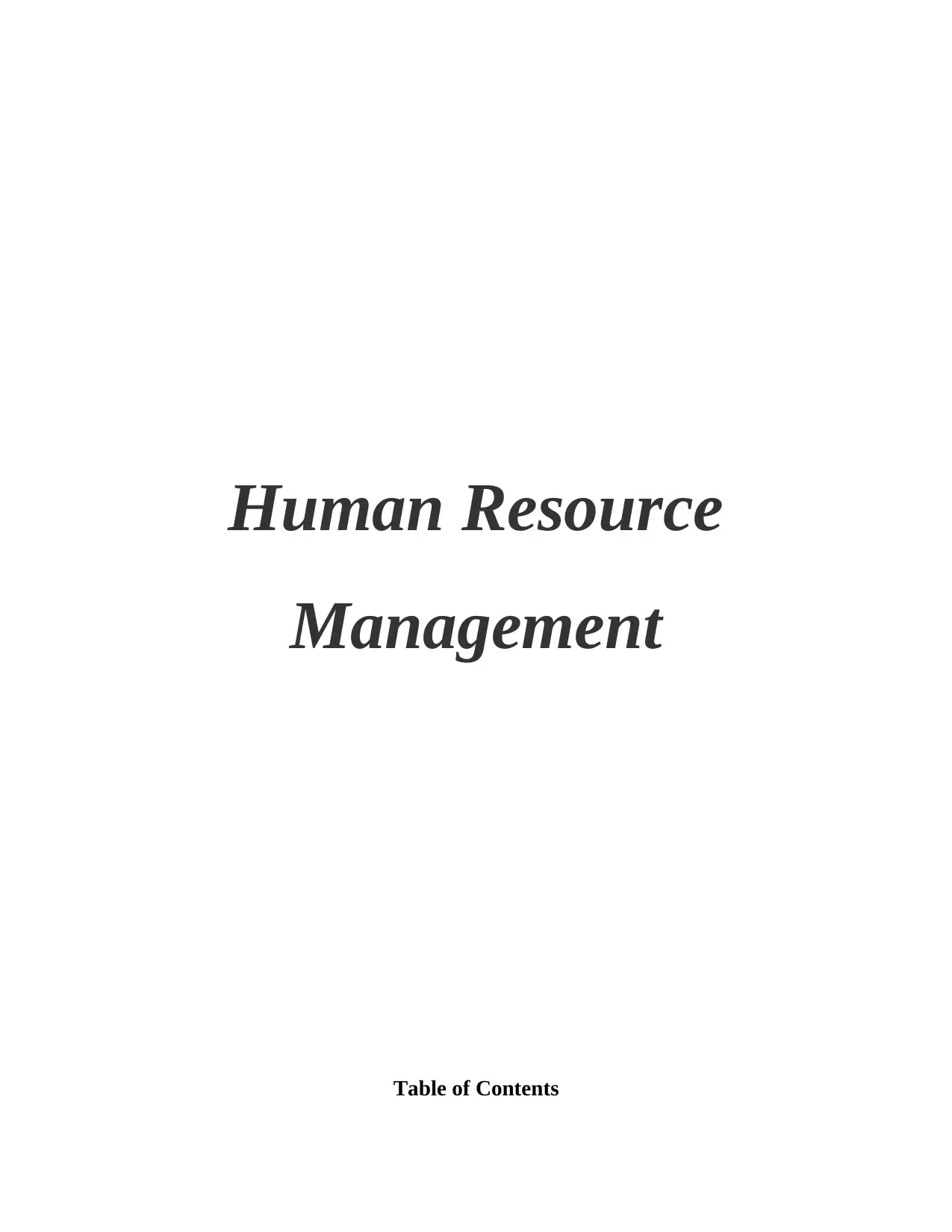
Human Resource
Management
Table of Contents
Management
Table of Contents
Paraphrase This Document
Need a fresh take? Get an instant paraphrase of this document with our AI Paraphraser
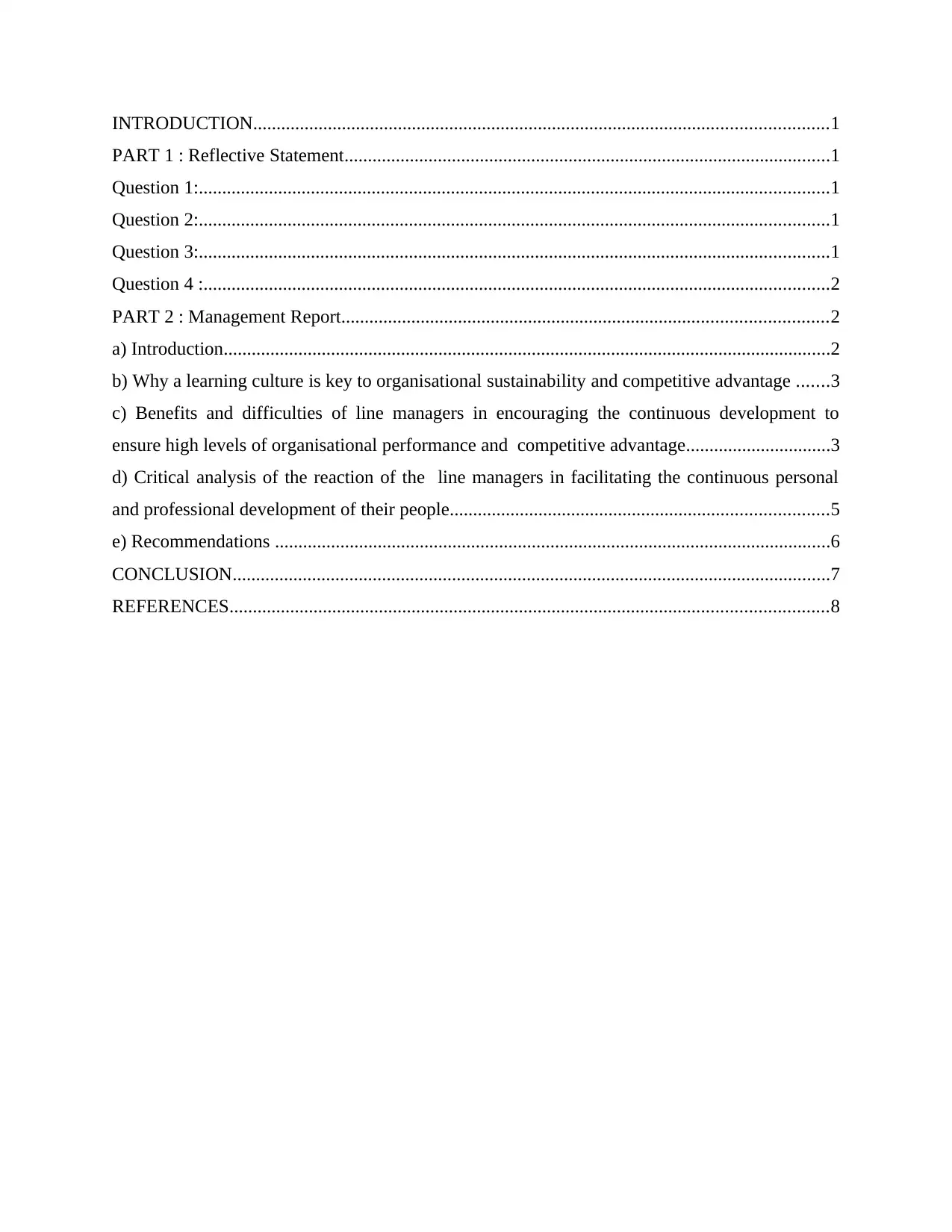
INTRODUCTION...........................................................................................................................1
PART 1 : Reflective Statement........................................................................................................1
Question 1:.......................................................................................................................................1
Question 2:.......................................................................................................................................1
Question 3:.......................................................................................................................................1
Question 4 :......................................................................................................................................2
PART 2 : Management Report........................................................................................................2
a) Introduction..................................................................................................................................2
b) Why a learning culture is key to organisational sustainability and competitive advantage .......3
c) Benefits and difficulties of line managers in encouraging the continuous development to
ensure high levels of organisational performance and competitive advantage...............................3
d) Critical analysis of the reaction of the line managers in facilitating the continuous personal
and professional development of their people.................................................................................5
e) Recommendations .......................................................................................................................6
CONCLUSION................................................................................................................................7
REFERENCES................................................................................................................................8
PART 1 : Reflective Statement........................................................................................................1
Question 1:.......................................................................................................................................1
Question 2:.......................................................................................................................................1
Question 3:.......................................................................................................................................1
Question 4 :......................................................................................................................................2
PART 2 : Management Report........................................................................................................2
a) Introduction..................................................................................................................................2
b) Why a learning culture is key to organisational sustainability and competitive advantage .......3
c) Benefits and difficulties of line managers in encouraging the continuous development to
ensure high levels of organisational performance and competitive advantage...............................3
d) Critical analysis of the reaction of the line managers in facilitating the continuous personal
and professional development of their people.................................................................................5
e) Recommendations .......................................................................................................................6
CONCLUSION................................................................................................................................7
REFERENCES................................................................................................................................8

⊘ This is a preview!⊘
Do you want full access?
Subscribe today to unlock all pages.

Trusted by 1+ million students worldwide
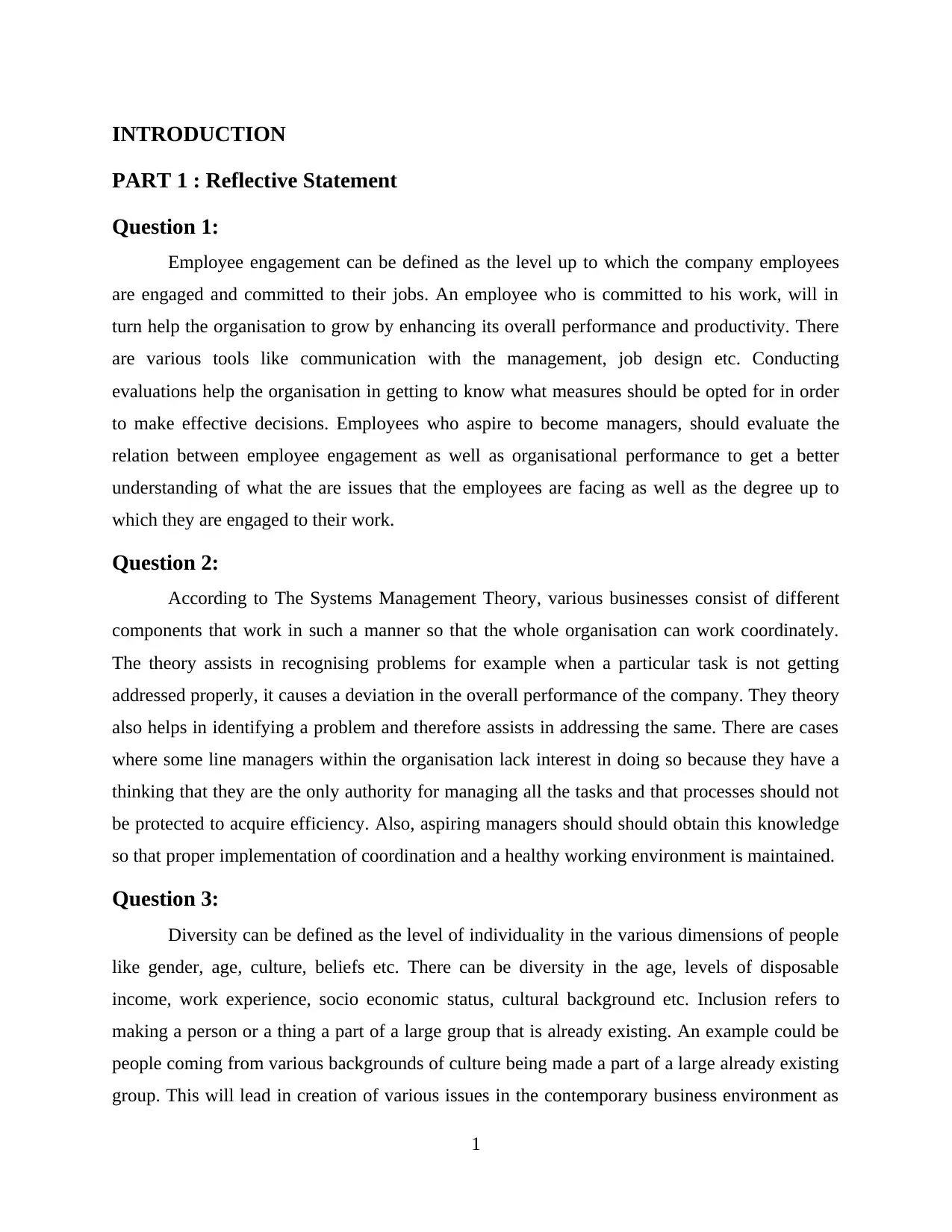
INTRODUCTION
PART 1 : Reflective Statement
Question 1:
Employee engagement can be defined as the level up to which the company employees
are engaged and committed to their jobs. An employee who is committed to his work, will in
turn help the organisation to grow by enhancing its overall performance and productivity. There
are various tools like communication with the management, job design etc. Conducting
evaluations help the organisation in getting to know what measures should be opted for in order
to make effective decisions. Employees who aspire to become managers, should evaluate the
relation between employee engagement as well as organisational performance to get a better
understanding of what the are issues that the employees are facing as well as the degree up to
which they are engaged to their work.
Question 2:
According to The Systems Management Theory, various businesses consist of different
components that work in such a manner so that the whole organisation can work coordinately.
The theory assists in recognising problems for example when a particular task is not getting
addressed properly, it causes a deviation in the overall performance of the company. They theory
also helps in identifying a problem and therefore assists in addressing the same. There are cases
where some line managers within the organisation lack interest in doing so because they have a
thinking that they are the only authority for managing all the tasks and that processes should not
be protected to acquire efficiency. Also, aspiring managers should should obtain this knowledge
so that proper implementation of coordination and a healthy working environment is maintained.
Question 3:
Diversity can be defined as the level of individuality in the various dimensions of people
like gender, age, culture, beliefs etc. There can be diversity in the age, levels of disposable
income, work experience, socio economic status, cultural background etc. Inclusion refers to
making a person or a thing a part of a large group that is already existing. An example could be
people coming from various backgrounds of culture being made a part of a large already existing
group. This will lead in creation of various issues in the contemporary business environment as
1
PART 1 : Reflective Statement
Question 1:
Employee engagement can be defined as the level up to which the company employees
are engaged and committed to their jobs. An employee who is committed to his work, will in
turn help the organisation to grow by enhancing its overall performance and productivity. There
are various tools like communication with the management, job design etc. Conducting
evaluations help the organisation in getting to know what measures should be opted for in order
to make effective decisions. Employees who aspire to become managers, should evaluate the
relation between employee engagement as well as organisational performance to get a better
understanding of what the are issues that the employees are facing as well as the degree up to
which they are engaged to their work.
Question 2:
According to The Systems Management Theory, various businesses consist of different
components that work in such a manner so that the whole organisation can work coordinately.
The theory assists in recognising problems for example when a particular task is not getting
addressed properly, it causes a deviation in the overall performance of the company. They theory
also helps in identifying a problem and therefore assists in addressing the same. There are cases
where some line managers within the organisation lack interest in doing so because they have a
thinking that they are the only authority for managing all the tasks and that processes should not
be protected to acquire efficiency. Also, aspiring managers should should obtain this knowledge
so that proper implementation of coordination and a healthy working environment is maintained.
Question 3:
Diversity can be defined as the level of individuality in the various dimensions of people
like gender, age, culture, beliefs etc. There can be diversity in the age, levels of disposable
income, work experience, socio economic status, cultural background etc. Inclusion refers to
making a person or a thing a part of a large group that is already existing. An example could be
people coming from various backgrounds of culture being made a part of a large already existing
group. This will lead in creation of various issues in the contemporary business environment as
1
Paraphrase This Document
Need a fresh take? Get an instant paraphrase of this document with our AI Paraphraser
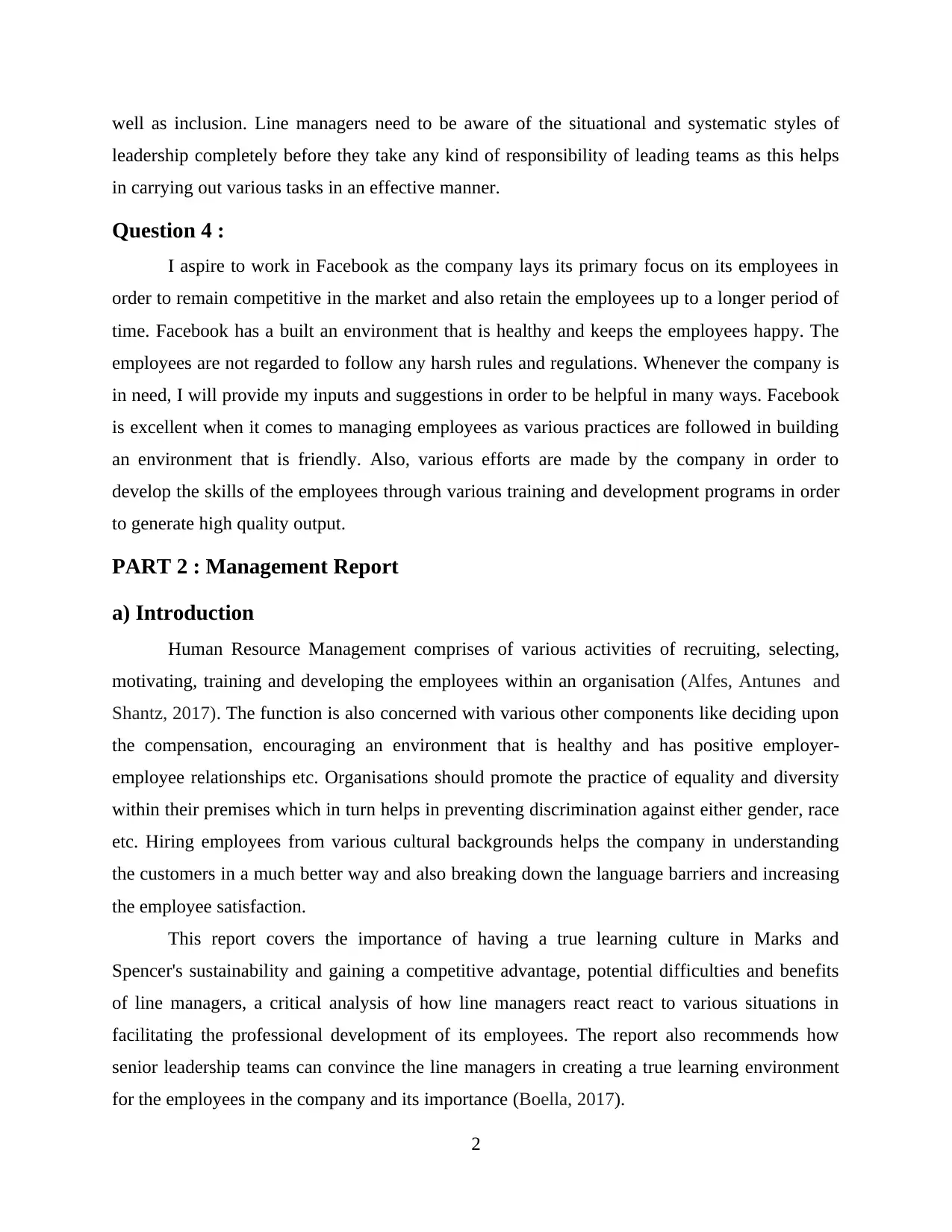
well as inclusion. Line managers need to be aware of the situational and systematic styles of
leadership completely before they take any kind of responsibility of leading teams as this helps
in carrying out various tasks in an effective manner.
Question 4 :
I aspire to work in Facebook as the company lays its primary focus on its employees in
order to remain competitive in the market and also retain the employees up to a longer period of
time. Facebook has a built an environment that is healthy and keeps the employees happy. The
employees are not regarded to follow any harsh rules and regulations. Whenever the company is
in need, I will provide my inputs and suggestions in order to be helpful in many ways. Facebook
is excellent when it comes to managing employees as various practices are followed in building
an environment that is friendly. Also, various efforts are made by the company in order to
develop the skills of the employees through various training and development programs in order
to generate high quality output.
PART 2 : Management Report
a) Introduction
Human Resource Management comprises of various activities of recruiting, selecting,
motivating, training and developing the employees within an organisation (Alfes, Antunes and
Shantz, 2017). The function is also concerned with various other components like deciding upon
the compensation, encouraging an environment that is healthy and has positive employer-
employee relationships etc. Organisations should promote the practice of equality and diversity
within their premises which in turn helps in preventing discrimination against either gender, race
etc. Hiring employees from various cultural backgrounds helps the company in understanding
the customers in a much better way and also breaking down the language barriers and increasing
the employee satisfaction.
This report covers the importance of having a true learning culture in Marks and
Spencer's sustainability and gaining a competitive advantage, potential difficulties and benefits
of line managers, a critical analysis of how line managers react react to various situations in
facilitating the professional development of its employees. The report also recommends how
senior leadership teams can convince the line managers in creating a true learning environment
for the employees in the company and its importance (Boella, 2017).
2
leadership completely before they take any kind of responsibility of leading teams as this helps
in carrying out various tasks in an effective manner.
Question 4 :
I aspire to work in Facebook as the company lays its primary focus on its employees in
order to remain competitive in the market and also retain the employees up to a longer period of
time. Facebook has a built an environment that is healthy and keeps the employees happy. The
employees are not regarded to follow any harsh rules and regulations. Whenever the company is
in need, I will provide my inputs and suggestions in order to be helpful in many ways. Facebook
is excellent when it comes to managing employees as various practices are followed in building
an environment that is friendly. Also, various efforts are made by the company in order to
develop the skills of the employees through various training and development programs in order
to generate high quality output.
PART 2 : Management Report
a) Introduction
Human Resource Management comprises of various activities of recruiting, selecting,
motivating, training and developing the employees within an organisation (Alfes, Antunes and
Shantz, 2017). The function is also concerned with various other components like deciding upon
the compensation, encouraging an environment that is healthy and has positive employer-
employee relationships etc. Organisations should promote the practice of equality and diversity
within their premises which in turn helps in preventing discrimination against either gender, race
etc. Hiring employees from various cultural backgrounds helps the company in understanding
the customers in a much better way and also breaking down the language barriers and increasing
the employee satisfaction.
This report covers the importance of having a true learning culture in Marks and
Spencer's sustainability and gaining a competitive advantage, potential difficulties and benefits
of line managers, a critical analysis of how line managers react react to various situations in
facilitating the professional development of its employees. The report also recommends how
senior leadership teams can convince the line managers in creating a true learning environment
for the employees in the company and its importance (Boella, 2017).
2
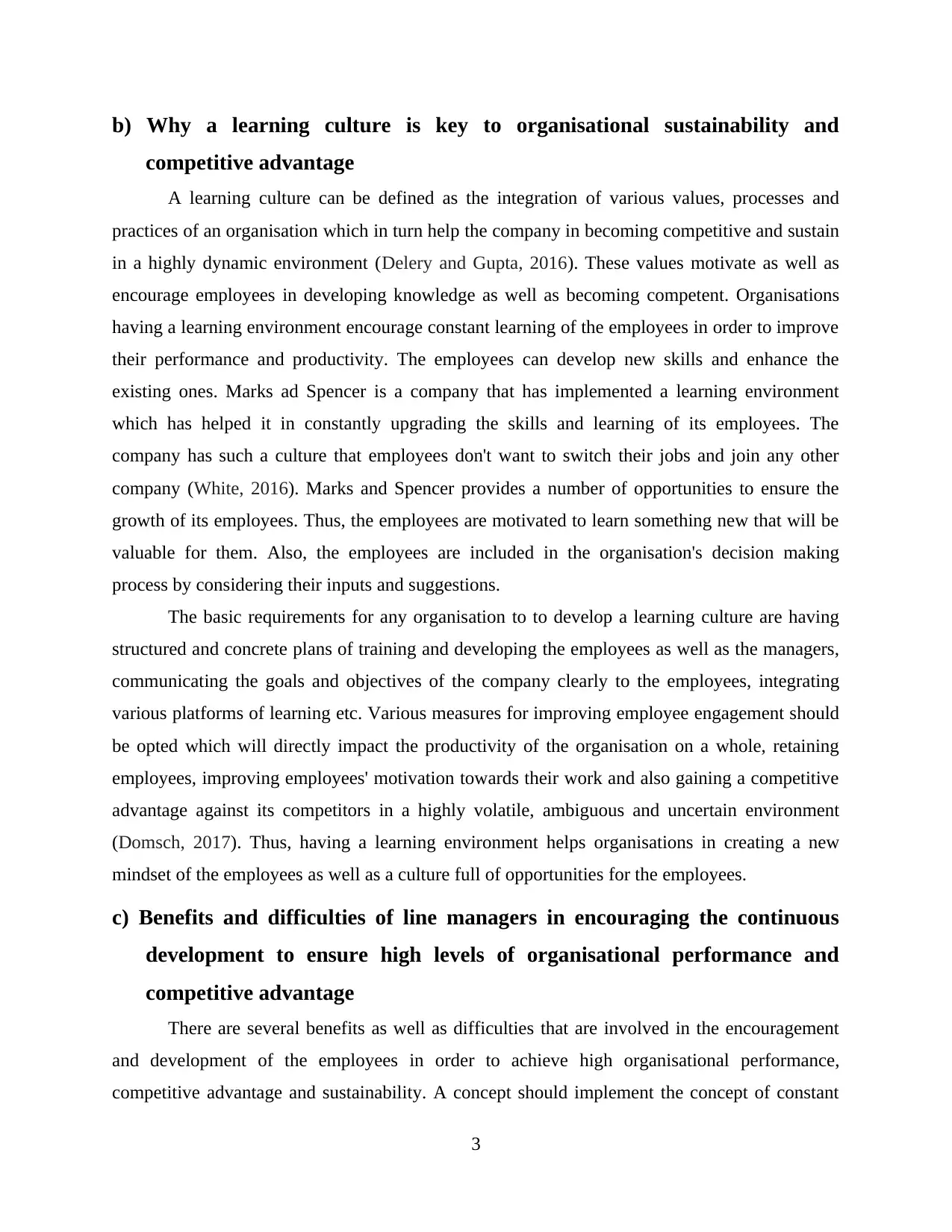
b) Why a learning culture is key to organisational sustainability and
competitive advantage
A learning culture can be defined as the integration of various values, processes and
practices of an organisation which in turn help the company in becoming competitive and sustain
in a highly dynamic environment (Delery and Gupta, 2016). These values motivate as well as
encourage employees in developing knowledge as well as becoming competent. Organisations
having a learning environment encourage constant learning of the employees in order to improve
their performance and productivity. The employees can develop new skills and enhance the
existing ones. Marks ad Spencer is a company that has implemented a learning environment
which has helped it in constantly upgrading the skills and learning of its employees. The
company has such a culture that employees don't want to switch their jobs and join any other
company (White, 2016). Marks and Spencer provides a number of opportunities to ensure the
growth of its employees. Thus, the employees are motivated to learn something new that will be
valuable for them. Also, the employees are included in the organisation's decision making
process by considering their inputs and suggestions.
The basic requirements for any organisation to to develop a learning culture are having
structured and concrete plans of training and developing the employees as well as the managers,
communicating the goals and objectives of the company clearly to the employees, integrating
various platforms of learning etc. Various measures for improving employee engagement should
be opted which will directly impact the productivity of the organisation on a whole, retaining
employees, improving employees' motivation towards their work and also gaining a competitive
advantage against its competitors in a highly volatile, ambiguous and uncertain environment
(Domsch, 2017). Thus, having a learning environment helps organisations in creating a new
mindset of the employees as well as a culture full of opportunities for the employees.
c) Benefits and difficulties of line managers in encouraging the continuous
development to ensure high levels of organisational performance and
competitive advantage
There are several benefits as well as difficulties that are involved in the encouragement
and development of the employees in order to achieve high organisational performance,
competitive advantage and sustainability. A concept should implement the concept of constant
3
competitive advantage
A learning culture can be defined as the integration of various values, processes and
practices of an organisation which in turn help the company in becoming competitive and sustain
in a highly dynamic environment (Delery and Gupta, 2016). These values motivate as well as
encourage employees in developing knowledge as well as becoming competent. Organisations
having a learning environment encourage constant learning of the employees in order to improve
their performance and productivity. The employees can develop new skills and enhance the
existing ones. Marks ad Spencer is a company that has implemented a learning environment
which has helped it in constantly upgrading the skills and learning of its employees. The
company has such a culture that employees don't want to switch their jobs and join any other
company (White, 2016). Marks and Spencer provides a number of opportunities to ensure the
growth of its employees. Thus, the employees are motivated to learn something new that will be
valuable for them. Also, the employees are included in the organisation's decision making
process by considering their inputs and suggestions.
The basic requirements for any organisation to to develop a learning culture are having
structured and concrete plans of training and developing the employees as well as the managers,
communicating the goals and objectives of the company clearly to the employees, integrating
various platforms of learning etc. Various measures for improving employee engagement should
be opted which will directly impact the productivity of the organisation on a whole, retaining
employees, improving employees' motivation towards their work and also gaining a competitive
advantage against its competitors in a highly volatile, ambiguous and uncertain environment
(Domsch, 2017). Thus, having a learning environment helps organisations in creating a new
mindset of the employees as well as a culture full of opportunities for the employees.
c) Benefits and difficulties of line managers in encouraging the continuous
development to ensure high levels of organisational performance and
competitive advantage
There are several benefits as well as difficulties that are involved in the encouragement
and development of the employees in order to achieve high organisational performance,
competitive advantage and sustainability. A concept should implement the concept of constant
3
⊘ This is a preview!⊘
Do you want full access?
Subscribe today to unlock all pages.

Trusted by 1+ million students worldwide
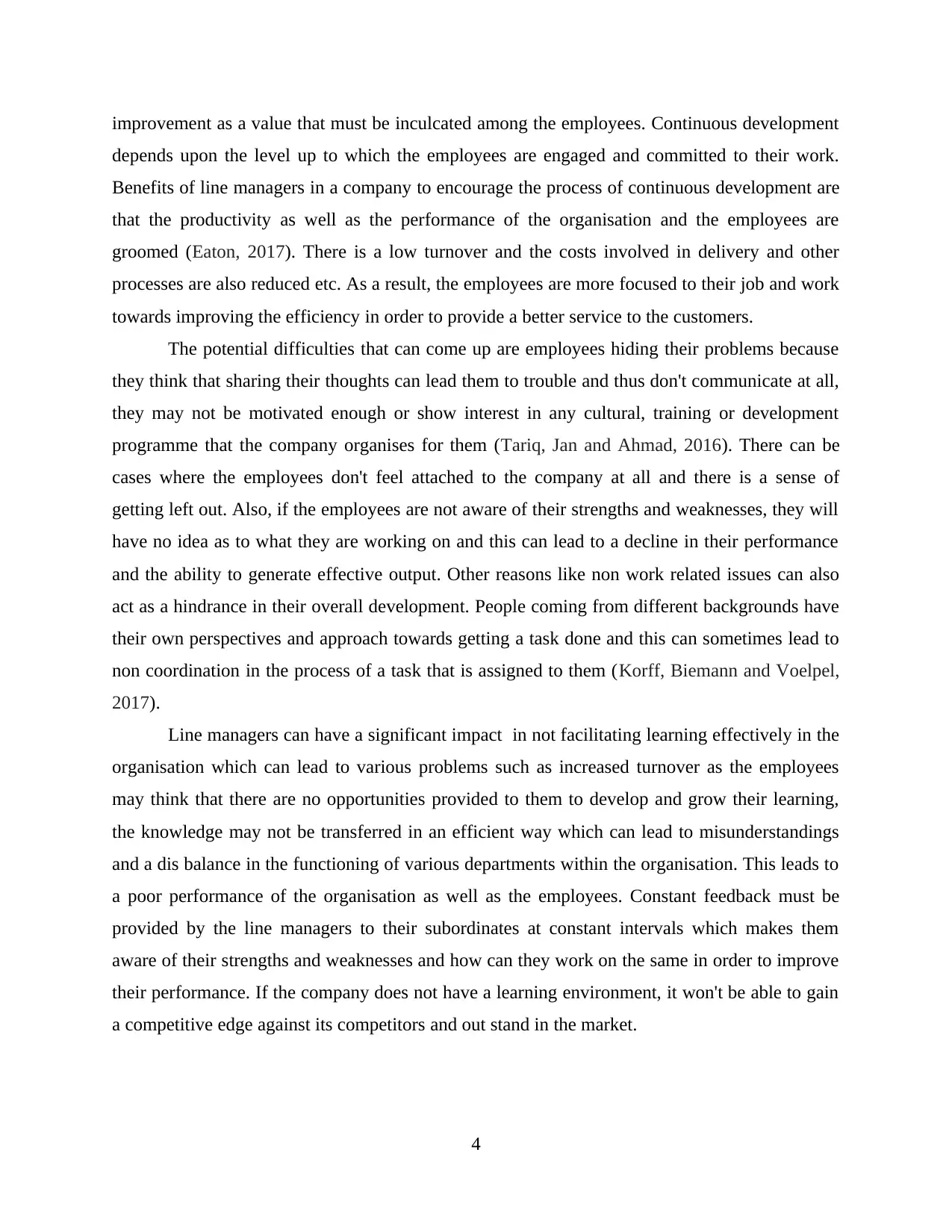
improvement as a value that must be inculcated among the employees. Continuous development
depends upon the level up to which the employees are engaged and committed to their work.
Benefits of line managers in a company to encourage the process of continuous development are
that the productivity as well as the performance of the organisation and the employees are
groomed (Eaton, 2017). There is a low turnover and the costs involved in delivery and other
processes are also reduced etc. As a result, the employees are more focused to their job and work
towards improving the efficiency in order to provide a better service to the customers.
The potential difficulties that can come up are employees hiding their problems because
they think that sharing their thoughts can lead them to trouble and thus don't communicate at all,
they may not be motivated enough or show interest in any cultural, training or development
programme that the company organises for them (Tariq, Jan and Ahmad, 2016). There can be
cases where the employees don't feel attached to the company at all and there is a sense of
getting left out. Also, if the employees are not aware of their strengths and weaknesses, they will
have no idea as to what they are working on and this can lead to a decline in their performance
and the ability to generate effective output. Other reasons like non work related issues can also
act as a hindrance in their overall development. People coming from different backgrounds have
their own perspectives and approach towards getting a task done and this can sometimes lead to
non coordination in the process of a task that is assigned to them (Korff, Biemann and Voelpel,
2017).
Line managers can have a significant impact in not facilitating learning effectively in the
organisation which can lead to various problems such as increased turnover as the employees
may think that there are no opportunities provided to them to develop and grow their learning,
the knowledge may not be transferred in an efficient way which can lead to misunderstandings
and a dis balance in the functioning of various departments within the organisation. This leads to
a poor performance of the organisation as well as the employees. Constant feedback must be
provided by the line managers to their subordinates at constant intervals which makes them
aware of their strengths and weaknesses and how can they work on the same in order to improve
their performance. If the company does not have a learning environment, it won't be able to gain
a competitive edge against its competitors and out stand in the market.
4
depends upon the level up to which the employees are engaged and committed to their work.
Benefits of line managers in a company to encourage the process of continuous development are
that the productivity as well as the performance of the organisation and the employees are
groomed (Eaton, 2017). There is a low turnover and the costs involved in delivery and other
processes are also reduced etc. As a result, the employees are more focused to their job and work
towards improving the efficiency in order to provide a better service to the customers.
The potential difficulties that can come up are employees hiding their problems because
they think that sharing their thoughts can lead them to trouble and thus don't communicate at all,
they may not be motivated enough or show interest in any cultural, training or development
programme that the company organises for them (Tariq, Jan and Ahmad, 2016). There can be
cases where the employees don't feel attached to the company at all and there is a sense of
getting left out. Also, if the employees are not aware of their strengths and weaknesses, they will
have no idea as to what they are working on and this can lead to a decline in their performance
and the ability to generate effective output. Other reasons like non work related issues can also
act as a hindrance in their overall development. People coming from different backgrounds have
their own perspectives and approach towards getting a task done and this can sometimes lead to
non coordination in the process of a task that is assigned to them (Korff, Biemann and Voelpel,
2017).
Line managers can have a significant impact in not facilitating learning effectively in the
organisation which can lead to various problems such as increased turnover as the employees
may think that there are no opportunities provided to them to develop and grow their learning,
the knowledge may not be transferred in an efficient way which can lead to misunderstandings
and a dis balance in the functioning of various departments within the organisation. This leads to
a poor performance of the organisation as well as the employees. Constant feedback must be
provided by the line managers to their subordinates at constant intervals which makes them
aware of their strengths and weaknesses and how can they work on the same in order to improve
their performance. If the company does not have a learning environment, it won't be able to gain
a competitive edge against its competitors and out stand in the market.
4
Paraphrase This Document
Need a fresh take? Get an instant paraphrase of this document with our AI Paraphraser
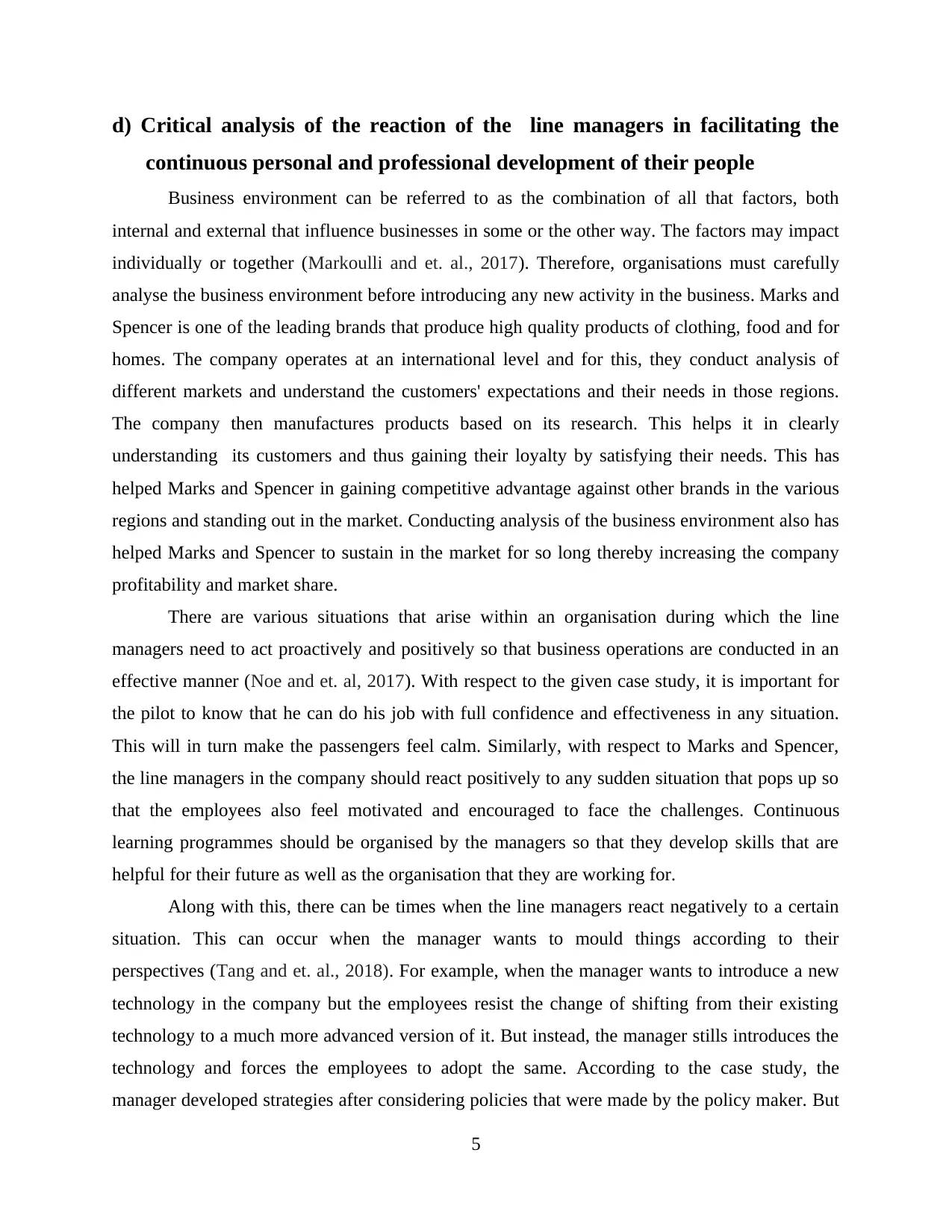
d) Critical analysis of the reaction of the line managers in facilitating the
continuous personal and professional development of their people
Business environment can be referred to as the combination of all that factors, both
internal and external that influence businesses in some or the other way. The factors may impact
individually or together (Markoulli and et. al., 2017). Therefore, organisations must carefully
analyse the business environment before introducing any new activity in the business. Marks and
Spencer is one of the leading brands that produce high quality products of clothing, food and for
homes. The company operates at an international level and for this, they conduct analysis of
different markets and understand the customers' expectations and their needs in those regions.
The company then manufactures products based on its research. This helps it in clearly
understanding its customers and thus gaining their loyalty by satisfying their needs. This has
helped Marks and Spencer in gaining competitive advantage against other brands in the various
regions and standing out in the market. Conducting analysis of the business environment also has
helped Marks and Spencer to sustain in the market for so long thereby increasing the company
profitability and market share.
There are various situations that arise within an organisation during which the line
managers need to act proactively and positively so that business operations are conducted in an
effective manner (Noe and et. al, 2017). With respect to the given case study, it is important for
the pilot to know that he can do his job with full confidence and effectiveness in any situation.
This will in turn make the passengers feel calm. Similarly, with respect to Marks and Spencer,
the line managers in the company should react positively to any sudden situation that pops up so
that the employees also feel motivated and encouraged to face the challenges. Continuous
learning programmes should be organised by the managers so that they develop skills that are
helpful for their future as well as the organisation that they are working for.
Along with this, there can be times when the line managers react negatively to a certain
situation. This can occur when the manager wants to mould things according to their
perspectives (Tang and et. al., 2018). For example, when the manager wants to introduce a new
technology in the company but the employees resist the change of shifting from their existing
technology to a much more advanced version of it. But instead, the manager stills introduces the
technology and forces the employees to adopt the same. According to the case study, the
manager developed strategies after considering policies that were made by the policy maker. But
5
continuous personal and professional development of their people
Business environment can be referred to as the combination of all that factors, both
internal and external that influence businesses in some or the other way. The factors may impact
individually or together (Markoulli and et. al., 2017). Therefore, organisations must carefully
analyse the business environment before introducing any new activity in the business. Marks and
Spencer is one of the leading brands that produce high quality products of clothing, food and for
homes. The company operates at an international level and for this, they conduct analysis of
different markets and understand the customers' expectations and their needs in those regions.
The company then manufactures products based on its research. This helps it in clearly
understanding its customers and thus gaining their loyalty by satisfying their needs. This has
helped Marks and Spencer in gaining competitive advantage against other brands in the various
regions and standing out in the market. Conducting analysis of the business environment also has
helped Marks and Spencer to sustain in the market for so long thereby increasing the company
profitability and market share.
There are various situations that arise within an organisation during which the line
managers need to act proactively and positively so that business operations are conducted in an
effective manner (Noe and et. al, 2017). With respect to the given case study, it is important for
the pilot to know that he can do his job with full confidence and effectiveness in any situation.
This will in turn make the passengers feel calm. Similarly, with respect to Marks and Spencer,
the line managers in the company should react positively to any sudden situation that pops up so
that the employees also feel motivated and encouraged to face the challenges. Continuous
learning programmes should be organised by the managers so that they develop skills that are
helpful for their future as well as the organisation that they are working for.
Along with this, there can be times when the line managers react negatively to a certain
situation. This can occur when the manager wants to mould things according to their
perspectives (Tang and et. al., 2018). For example, when the manager wants to introduce a new
technology in the company but the employees resist the change of shifting from their existing
technology to a much more advanced version of it. But instead, the manager stills introduces the
technology and forces the employees to adopt the same. According to the case study, the
manager developed strategies after considering policies that were made by the policy maker. But
5
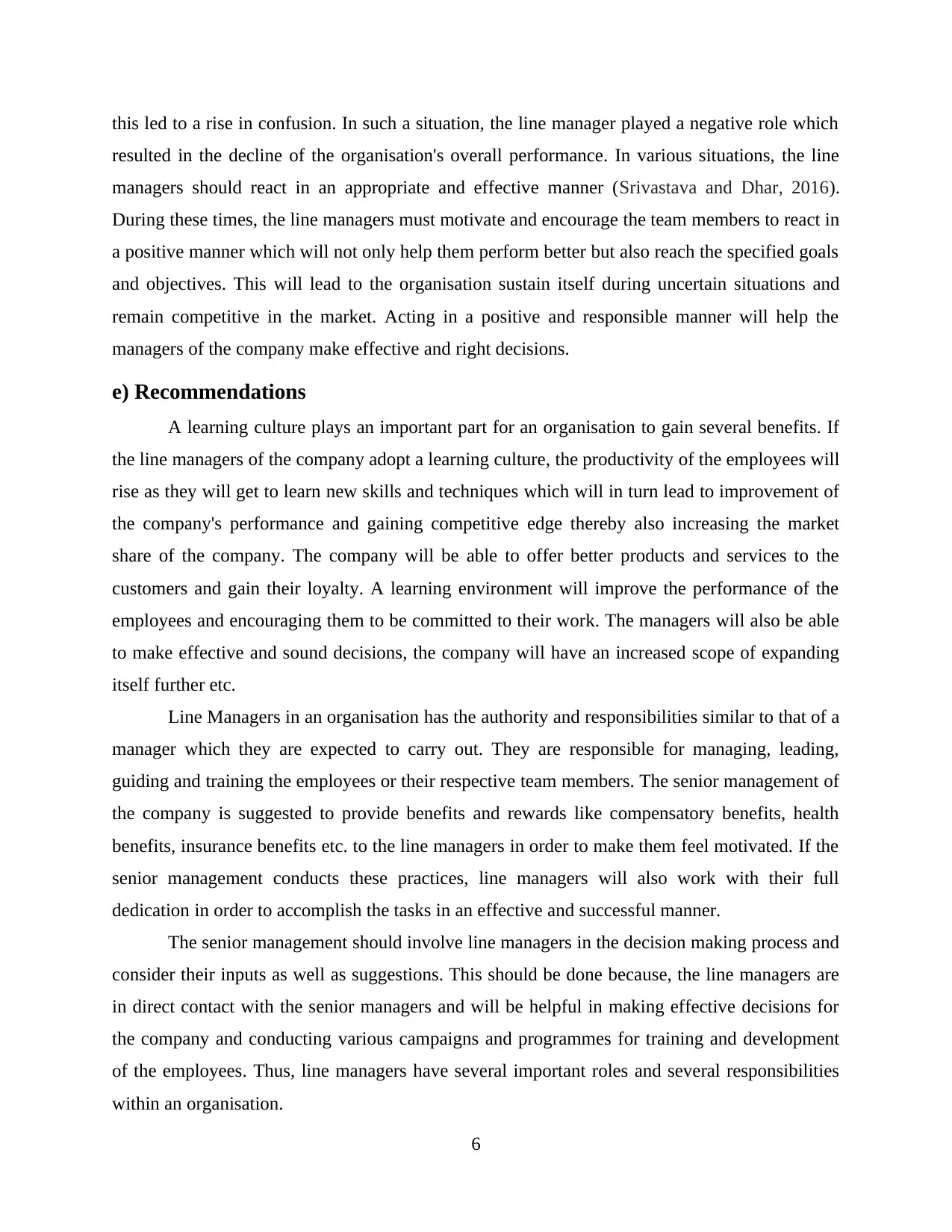
this led to a rise in confusion. In such a situation, the line manager played a negative role which
resulted in the decline of the organisation's overall performance. In various situations, the line
managers should react in an appropriate and effective manner (Srivastava and Dhar, 2016).
During these times, the line managers must motivate and encourage the team members to react in
a positive manner which will not only help them perform better but also reach the specified goals
and objectives. This will lead to the organisation sustain itself during uncertain situations and
remain competitive in the market. Acting in a positive and responsible manner will help the
managers of the company make effective and right decisions.
e) Recommendations
A learning culture plays an important part for an organisation to gain several benefits. If
the line managers of the company adopt a learning culture, the productivity of the employees will
rise as they will get to learn new skills and techniques which will in turn lead to improvement of
the company's performance and gaining competitive edge thereby also increasing the market
share of the company. The company will be able to offer better products and services to the
customers and gain their loyalty. A learning environment will improve the performance of the
employees and encouraging them to be committed to their work. The managers will also be able
to make effective and sound decisions, the company will have an increased scope of expanding
itself further etc.
Line Managers in an organisation has the authority and responsibilities similar to that of a
manager which they are expected to carry out. They are responsible for managing, leading,
guiding and training the employees or their respective team members. The senior management of
the company is suggested to provide benefits and rewards like compensatory benefits, health
benefits, insurance benefits etc. to the line managers in order to make them feel motivated. If the
senior management conducts these practices, line managers will also work with their full
dedication in order to accomplish the tasks in an effective and successful manner.
The senior management should involve line managers in the decision making process and
consider their inputs as well as suggestions. This should be done because, the line managers are
in direct contact with the senior managers and will be helpful in making effective decisions for
the company and conducting various campaigns and programmes for training and development
of the employees. Thus, line managers have several important roles and several responsibilities
within an organisation.
6
resulted in the decline of the organisation's overall performance. In various situations, the line
managers should react in an appropriate and effective manner (Srivastava and Dhar, 2016).
During these times, the line managers must motivate and encourage the team members to react in
a positive manner which will not only help them perform better but also reach the specified goals
and objectives. This will lead to the organisation sustain itself during uncertain situations and
remain competitive in the market. Acting in a positive and responsible manner will help the
managers of the company make effective and right decisions.
e) Recommendations
A learning culture plays an important part for an organisation to gain several benefits. If
the line managers of the company adopt a learning culture, the productivity of the employees will
rise as they will get to learn new skills and techniques which will in turn lead to improvement of
the company's performance and gaining competitive edge thereby also increasing the market
share of the company. The company will be able to offer better products and services to the
customers and gain their loyalty. A learning environment will improve the performance of the
employees and encouraging them to be committed to their work. The managers will also be able
to make effective and sound decisions, the company will have an increased scope of expanding
itself further etc.
Line Managers in an organisation has the authority and responsibilities similar to that of a
manager which they are expected to carry out. They are responsible for managing, leading,
guiding and training the employees or their respective team members. The senior management of
the company is suggested to provide benefits and rewards like compensatory benefits, health
benefits, insurance benefits etc. to the line managers in order to make them feel motivated. If the
senior management conducts these practices, line managers will also work with their full
dedication in order to accomplish the tasks in an effective and successful manner.
The senior management should involve line managers in the decision making process and
consider their inputs as well as suggestions. This should be done because, the line managers are
in direct contact with the senior managers and will be helpful in making effective decisions for
the company and conducting various campaigns and programmes for training and development
of the employees. Thus, line managers have several important roles and several responsibilities
within an organisation.
6
⊘ This is a preview!⊘
Do you want full access?
Subscribe today to unlock all pages.

Trusted by 1+ million students worldwide
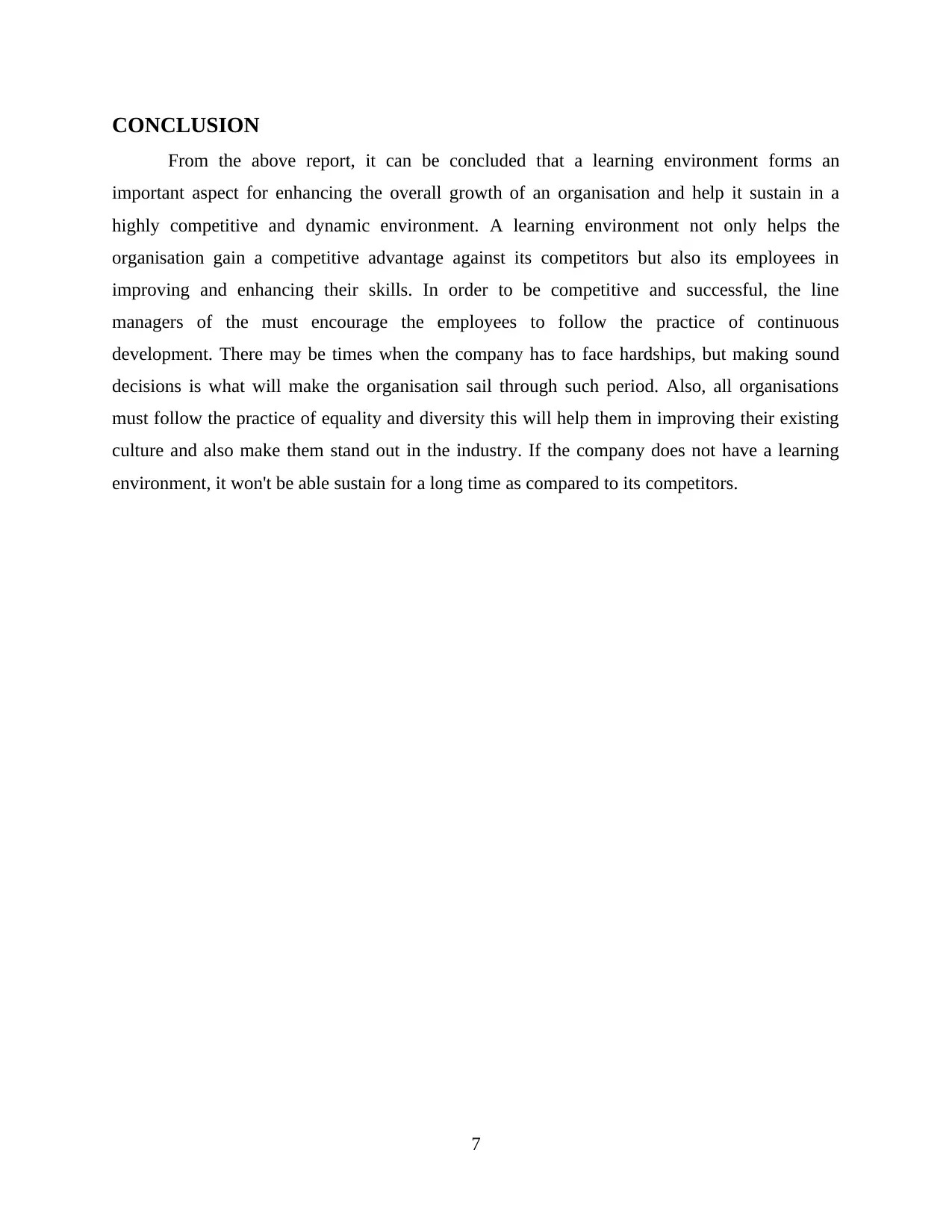
CONCLUSION
From the above report, it can be concluded that a learning environment forms an
important aspect for enhancing the overall growth of an organisation and help it sustain in a
highly competitive and dynamic environment. A learning environment not only helps the
organisation gain a competitive advantage against its competitors but also its employees in
improving and enhancing their skills. In order to be competitive and successful, the line
managers of the must encourage the employees to follow the practice of continuous
development. There may be times when the company has to face hardships, but making sound
decisions is what will make the organisation sail through such period. Also, all organisations
must follow the practice of equality and diversity this will help them in improving their existing
culture and also make them stand out in the industry. If the company does not have a learning
environment, it won't be able sustain for a long time as compared to its competitors.
7
From the above report, it can be concluded that a learning environment forms an
important aspect for enhancing the overall growth of an organisation and help it sustain in a
highly competitive and dynamic environment. A learning environment not only helps the
organisation gain a competitive advantage against its competitors but also its employees in
improving and enhancing their skills. In order to be competitive and successful, the line
managers of the must encourage the employees to follow the practice of continuous
development. There may be times when the company has to face hardships, but making sound
decisions is what will make the organisation sail through such period. Also, all organisations
must follow the practice of equality and diversity this will help them in improving their existing
culture and also make them stand out in the industry. If the company does not have a learning
environment, it won't be able sustain for a long time as compared to its competitors.
7
Paraphrase This Document
Need a fresh take? Get an instant paraphrase of this document with our AI Paraphraser
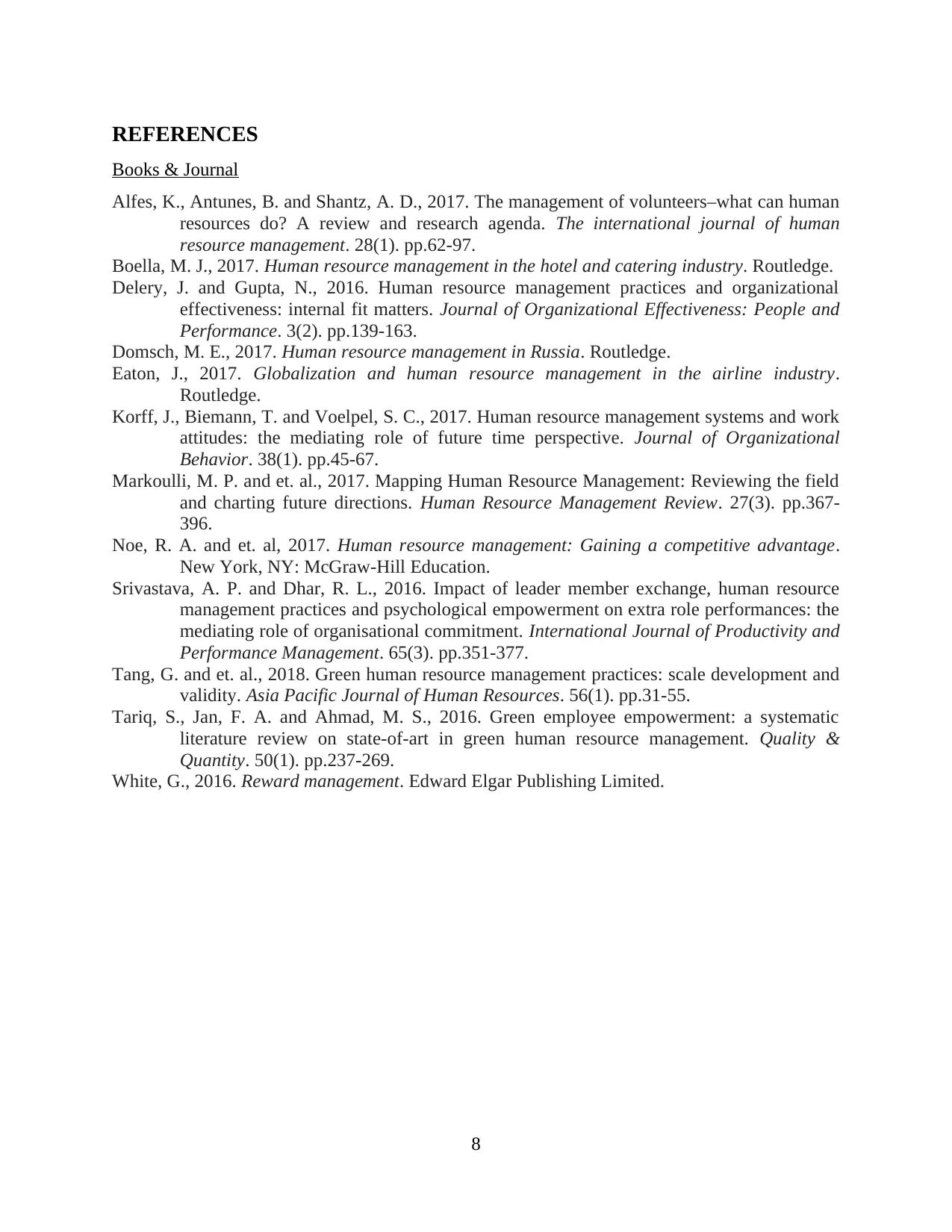
REFERENCES
Books & Journal
Alfes, K., Antunes, B. and Shantz, A. D., 2017. The management of volunteers–what can human
resources do? A review and research agenda. The international journal of human
resource management. 28(1). pp.62-97.
Boella, M. J., 2017. Human resource management in the hotel and catering industry. Routledge.
Delery, J. and Gupta, N., 2016. Human resource management practices and organizational
effectiveness: internal fit matters. Journal of Organizational Effectiveness: People and
Performance. 3(2). pp.139-163.
Domsch, M. E., 2017. Human resource management in Russia. Routledge.
Eaton, J., 2017. Globalization and human resource management in the airline industry.
Routledge.
Korff, J., Biemann, T. and Voelpel, S. C., 2017. Human resource management systems and work
attitudes: the mediating role of future time perspective. Journal of Organizational
Behavior. 38(1). pp.45-67.
Markoulli, M. P. and et. al., 2017. Mapping Human Resource Management: Reviewing the field
and charting future directions. Human Resource Management Review. 27(3). pp.367-
396.
Noe, R. A. and et. al, 2017. Human resource management: Gaining a competitive advantage.
New York, NY: McGraw-Hill Education.
Srivastava, A. P. and Dhar, R. L., 2016. Impact of leader member exchange, human resource
management practices and psychological empowerment on extra role performances: the
mediating role of organisational commitment. International Journal of Productivity and
Performance Management. 65(3). pp.351-377.
Tang, G. and et. al., 2018. Green human resource management practices: scale development and
validity. Asia Pacific Journal of Human Resources. 56(1). pp.31-55.
Tariq, S., Jan, F. A. and Ahmad, M. S., 2016. Green employee empowerment: a systematic
literature review on state-of-art in green human resource management. Quality &
Quantity. 50(1). pp.237-269.
White, G., 2016. Reward management. Edward Elgar Publishing Limited.
8
Books & Journal
Alfes, K., Antunes, B. and Shantz, A. D., 2017. The management of volunteers–what can human
resources do? A review and research agenda. The international journal of human
resource management. 28(1). pp.62-97.
Boella, M. J., 2017. Human resource management in the hotel and catering industry. Routledge.
Delery, J. and Gupta, N., 2016. Human resource management practices and organizational
effectiveness: internal fit matters. Journal of Organizational Effectiveness: People and
Performance. 3(2). pp.139-163.
Domsch, M. E., 2017. Human resource management in Russia. Routledge.
Eaton, J., 2017. Globalization and human resource management in the airline industry.
Routledge.
Korff, J., Biemann, T. and Voelpel, S. C., 2017. Human resource management systems and work
attitudes: the mediating role of future time perspective. Journal of Organizational
Behavior. 38(1). pp.45-67.
Markoulli, M. P. and et. al., 2017. Mapping Human Resource Management: Reviewing the field
and charting future directions. Human Resource Management Review. 27(3). pp.367-
396.
Noe, R. A. and et. al, 2017. Human resource management: Gaining a competitive advantage.
New York, NY: McGraw-Hill Education.
Srivastava, A. P. and Dhar, R. L., 2016. Impact of leader member exchange, human resource
management practices and psychological empowerment on extra role performances: the
mediating role of organisational commitment. International Journal of Productivity and
Performance Management. 65(3). pp.351-377.
Tang, G. and et. al., 2018. Green human resource management practices: scale development and
validity. Asia Pacific Journal of Human Resources. 56(1). pp.31-55.
Tariq, S., Jan, F. A. and Ahmad, M. S., 2016. Green employee empowerment: a systematic
literature review on state-of-art in green human resource management. Quality &
Quantity. 50(1). pp.237-269.
White, G., 2016. Reward management. Edward Elgar Publishing Limited.
8
1 out of 11
Related Documents
Your All-in-One AI-Powered Toolkit for Academic Success.
+13062052269
info@desklib.com
Available 24*7 on WhatsApp / Email
![[object Object]](/_next/static/media/star-bottom.7253800d.svg)
Unlock your academic potential
Copyright © 2020–2025 A2Z Services. All Rights Reserved. Developed and managed by ZUCOL.




